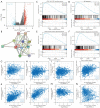The expression landscape of FOXP3 and its prognostic value in breast cancer
- PMID: 35965804
- PMCID: PMC9372690
- DOI: 10.21037/atm-22-3080
The expression landscape of FOXP3 and its prognostic value in breast cancer
Abstract
Background: Forkhead Box Protein 3 (FOXP3), as an essential marker of regulatory T cell (Treg) development, is reportedly overexpressed in invasive breast carcinoma (BRCA) and could be a potential prognostic factor for BRCA. However, the biological function of FOXP3 in BRCA is still unclear. In this study, we comprehensively explored the expression landscape of FOXP3 and its prognostic value in BRCA.
Methods: FOXP3 transcriptomic expression data were mainly obtained from The Cancer Genome Atlas (TCGA). The Kaplan-Meier plotter and receiver operating characteristic (ROC) curve were used to assess the prognostic and diagnostic value of FOXP3 in BRCA. UALCAN, cBio-Portal, and MethSurv were used to evaluate the genomic variation of FOXP3. Gene set enrichment analysis (GSEA) was performed to explore the FOXP3 pathways involved in BRCA. Morover, we detected the expression of FOXP3 in 123 BRCA specimens and 5 BRCA cell lines to verify the biological value of FOXP3 in BRCA. The Kaplan-Meier method was adopted for the overall survival (OS) analysis, and a Cox proportional hazards model was used to estimate the hazard ratio (HR) for OS.
Results: FOXP3 was more highly expressed in BRCA than in normal tissues (2.808±1.020 vs. 1.409±0.656, P<0.001), and overexpressed FOXP3 was associated with a better prognosis. The ROC curve demonstrated a significant diagnostic value of FOXP3 in BRCA (area under the ROC curve, AUC: 0.877). Genomic analysis revealed that promoter hypomethylation of FOXP3 may be the underlying mechanism of FOXP3's upregulation in BRCA. GSEA found that FOXP3 coexpressed genes were mainly involved in the Toll-like receptor pathway, JAK/STAT pathway, cell cycle, and apoptosis. Moreover, high FOXP3 expression was an independent protective factor for OS in our 123 BRCA tissues (HR: 0.367; P=0.036). In vitro, we found that FOXP3 knockdown with siRNA promoted migration and invasion in MCF-7 cells.
Conclusions: This study demonstrated that FOXP3 shows prognostic and diagnostic value for BRCA. We provided evidence that promoter hypomethylation and a high expression of FOXP3 were both related to a favorable prognosis in BRCA, which maybe associated with the Toll-like receptor pathway, JAK/STAT pathway, cell cycle, and apoptosis.
Keywords: Forkhead Box Protein 3 (FOXP3); The Cancer Genome Atlas (TCGA); breast carcinoma (BRCA); prognosis.
2022 Annals of Translational Medicine. All rights reserved.
Conflict of interest statement
Conflicts of Interest: All authors have completed the ICMJE uniform disclosure form (available at https://atm.amegroups.com/article/view/10.21037/atm-22-3080/coif). The authors have no conflicts of interest to declare.
Figures








References
LinkOut - more resources
Full Text Sources
